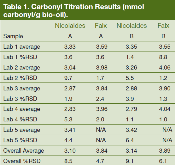Standardization of chemical analytical techniques for pyrolysis bio-oil: history, challenges, and current status of methods
- National Renewable Energy Lab. (NREL), Golden, CO (United States)
- Pacific Northwest National Lab. (PNNL), Richland, WA (United States)
- Oak Ridge National Lab. (ORNL), Oak Ridge, TN (United States)
- Washington State Univ., Pullman, WA (United States)
- Thunen Inst. of Wood Research (TI), Hamburg (Germany)
- VTT Technical Research Centre of Finland Ltd (VTT), Espoo (Finland)
Here in this perspective, we discuss the standardization of analytical techniques for pyrolysis bio-oils, including the current status of methods, and our opinions on future directions. First, the history of past standardization efforts is summarized, and both successful and unsuccessful validation of analytical techniques highlighted. The majority of analytical standardization studies to-date has tested only physical characterization techniques. Here, we present results from an international round robin on the validation of chemical characterization techniques for bio-oils. Techniques tested included acid number, carbonyl titrations using two different methods (one at room temperature and one at 80 °C), 31P NMR for determination of hydroxyl groups, and a quantitative gas chromatography-mass spectrometry (GC-MS) method. Both carbonyl titration and acid number methods have yielded acceptable inter-laboratory variabilities. 31P NMR produced acceptable results for aliphatic and phenolic hydroxyl groups, but not for carboxylic hydroxyl groups. As shown in previous round robins, GC-MS results were more variable. Reliable chemical characterization of bio-oils will enable upgrading research and allow for detailed comparisons of bio-oils produced at different facilities. Reliable analytics are also needed to enable an emerging bioenergy industry, as processing facilities often have different analytical needs and capabilities than research facilities. In conclusion, we feel that correlations in reliable characterizations of bio-oils will help strike a balance between research and industry, and will ultimately help to determine metrics for bio-oil quality. Finally, the standardization of additional analytical methods is needed, particularly for upgraded bio-oils.
- Research Organization:
- Oak Ridge National Laboratory (ORNL), Oak Ridge, TN (United States); National Renewable Energy Laboratory (NREL), Golden, CO (United States)
- Sponsoring Organization:
- USDOE Office of Energy Efficiency and Renewable Energy (EERE), Sustainable Transportation Office. Bioenergy Technologies Office
- Grant/Contract Number:
- AC05-00OR22725; AC36-08-GO28308; AC06-76RL01830; AC36-08GO28308
- OSTI ID:
- 1319212
- Alternate ID(s):
- OSTI ID: 1320384
- Report Number(s):
- NREL/JA-5100-65521
- Journal Information:
- Biofuels, Bioproducts & Biorefining, Vol. 10, Issue 5; ISSN 1932-104X
- Publisher:
- WileyCopyright Statement
- Country of Publication:
- United States
- Language:
- English
Web of Science
Molecular weight distribution of raw and catalytic fast pyrolysis oils: comparison of analytical methodologies
|
journal | January 2020 |
Similar Records
Characterization of the Water-Soluble Fraction of Woody Biomass Pyrolysis Oils
BETO 2021 Peer Review - Analytical Development and Standardization for Biomass-Derived Thermochemical Liquids



